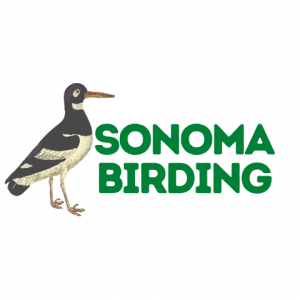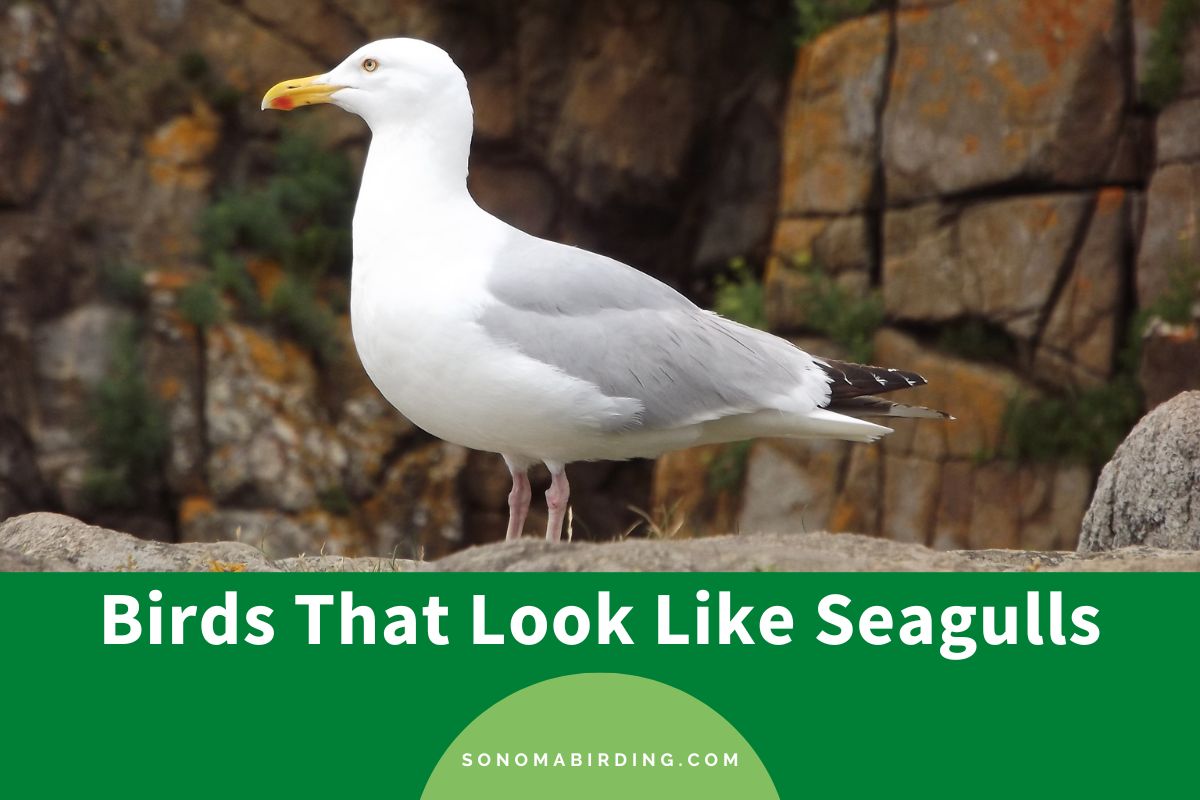“Look! That’s such a pretty seabird!”
“I bet they’re seagulls.”
“Are you sure?”
While gulls are quite popular seabirds, they’re not the only ones that populate the beaches and seasides. In fact, there are many other seabirds that resemble them closely – having the same medium-to-large size, shades of white, grey, and black on their plumage, webbed feet, and harsh calls – but they belong to different families and subfamilies.
In this article today, we’re going to talk about a bunch of seabird species that can easily be mistaken for a seagull from a fair distance but are actually their distant relatives (in most cases) with unique characteristics of their own. Let’s get started!
Northern Fulmar

Scientific name: Fulmarus glacialis
Lifespan: around 60 years
Height: 46 centimeters (18 inches)
Weight: 450 grams – 1 kilogram
Wingspan: 102-112 centimeters (40-44 inches)
Also referred to as the Arctic Fulmar, Northern Fulmars are large seabirds that densely populate the subarctic regions of the North Pacific and Atlantic Oceans.
While the resemblance of their appearance with the gulls is uncanny, this species actually belongs to a different family (of shearwaters and petrels).
Northern Fulmars appear in two color morphs. The dark morph is uniformly grey, while the lighter one shows more variation. Their head, neck, and body are white, coupled with grey wings and tails. However, both morphs have the same thick, yellowish bills and blue legs.
Because Northern Fulmars are sexually monomorphic, it’s difficult to tell the sexes apart.
Their resemblance to seagulls:
Due to their body structure and plumage coloration, Northern Fulmars can often be mistaken for gulls. Only their shorter legs and bills can set these birds apart.
Caspian Tern
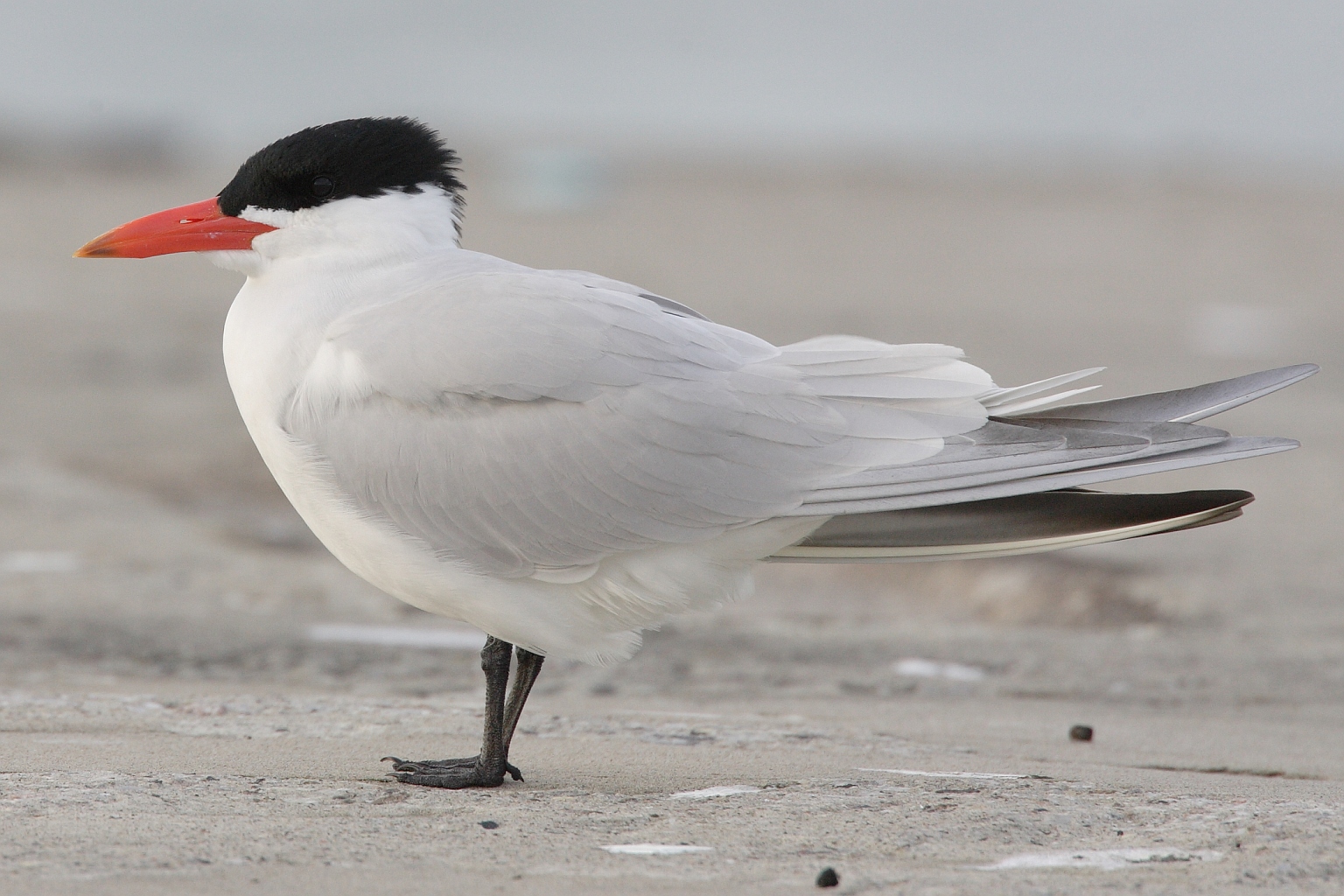
Scientific name: Hydroprogne caspia
Lifespan: around 12 years
Height: 48-60 centimeters (19-24 inches)
Weight: 530-728 kilograms
Wingspan: 127-145 centimeters (50-57 inches)
Named after the Caspian Sea, where they’re fairly common, Caspian Terns are the largest tern species in the world. These mighty seabirds spend their breeding months on the lakesides and coasts of North America and migrate south to the West Indies and northern regions of South America during winters.
Both the appearance and vocalization of Caspian Terns are easily recognizable. These heron-like croakers have an overall white body with touches of pale grey on their upper wings and back and black underwings, feet, and legs.
On their head, you’ll find a remarkably black cap covering their eyes, which grows pale grey in the non-breeding months. Their thick bills are reddish-orange in color with a faint black tip. Caspian Terns are sexually monomorphic, with both sexes having an identical appearance.
Their resemblance to seagulls:
While the plumage of Caspian Terns might resemble that of the gulls, these seabirds are larger in size and have a substantially longer wingspan (more than twice their own body length). Their bills are also long, thick, and without any hooks, unlike that of the gulls.
Northern Gannet
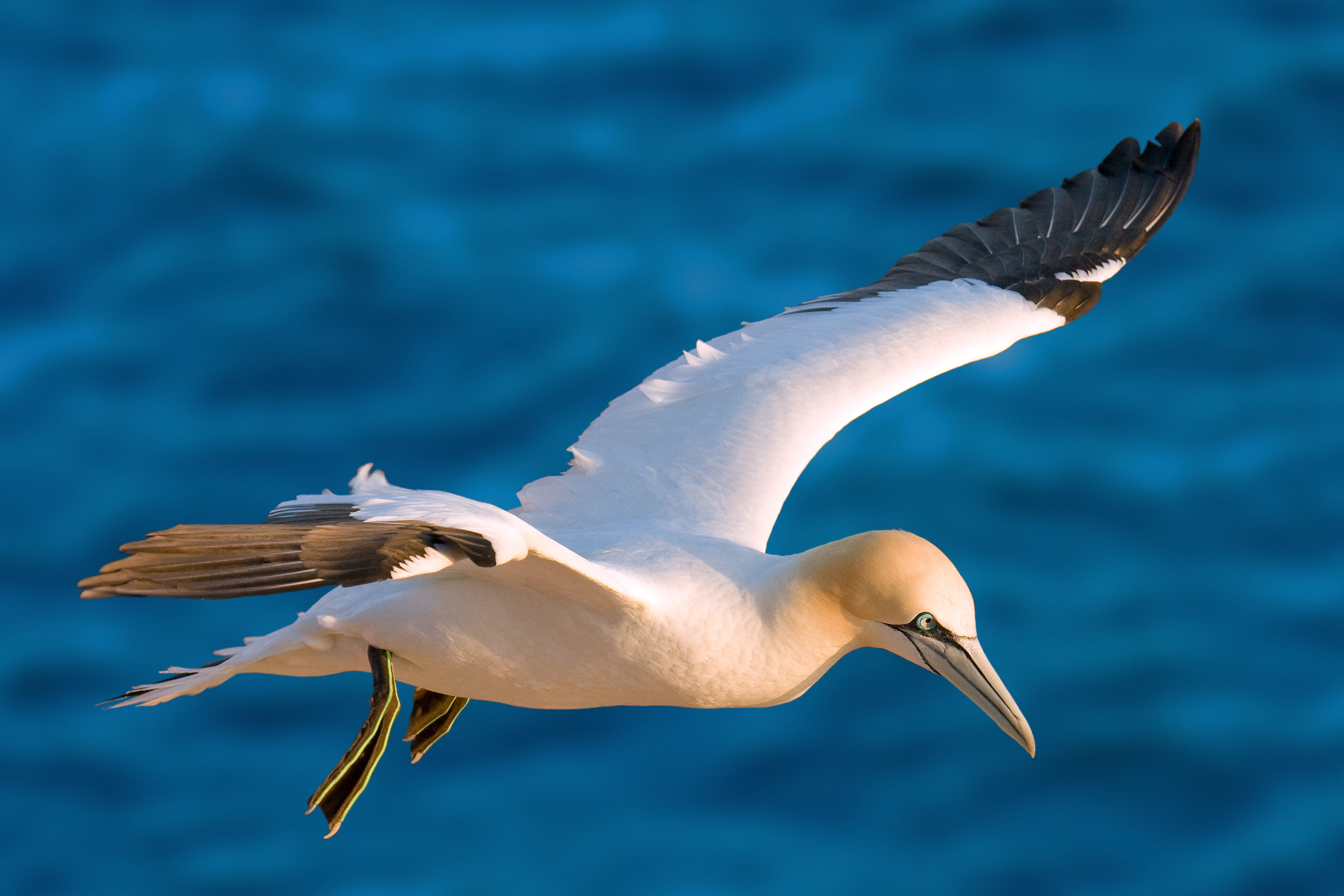
Scientific name: Morus bassanus
Lifespan: around 16-20 years
Height: 87-100 centimeters (34-39 inches)
Weight: 2.3-3.6 kilograms
Wingspan: 170-180 centimeters (67-71 inches)
The largest member of the Gannet family, Northern Gannets are large seabirds that are endemic to the coasts of the Atlantic Ocean. In North America, you’ll only spot them during their breeding months.
These high-speed divers are quite skilled at dive-catching fish from the sea, and prefer to dwell on islands with cliffs to facilitate easy launch into the air.
Both sexes of Northern Gannets are almost identical in appearance; only the plumage of the male is colored more vibrantly than their female counterpart. The males also have greenish-yellow lines running up their legs, which are bluish in the females.
Their overall plumage color remains white, with dark primary flight feathers and black wing tips. You’ll also notice a tinge of buff yellow on their head and neck, which grows darker in their breeding months.
The color of their eye ranges from light blue to light grey, with a bluish-grey bill that’s conical with a sharp edge curving downwards.
Their resemblance to seagulls:
Northern Gannets share black and white plumage coloration with gulls, but that’s where all their similarities end. Their bills are long, conical, and pointy-edged, unlike the shorter, hooked bills of gulls. They have buff touches on their head and neck, which the latter lack. Lastly, their webbed feet are four-toed and not three-toed like the gulls.
Black-browed Albatross

Scientific name: Thalassarche melanophris
Lifespan: around 70 years
Height: 80-95 centimeters (31-37 inches)
Weight: 2.9-4.7 kilograms
Wingspan: 200-240 centimeters (79-94 inches)
Considered the most commonly found member of the albatross family, Black-browed Albatrosses are also referred to as Black-browed Mollyhawk. These long-lived seabirds have an overall white body with contrasting dark grey upperwings.
Their appearance is easily comparable to the Campbell Albatrosses, except for the prominent dark brows that lend them their name.
The eyes of Black-browed Albatrosses, much like their eyebrows, are black, while their bill is yellow, with a dark reddish tip. Both sexes of the adults look identical, displaying little-to-no sexual dimorphism.
Their resemblance to seagulls:
The head, neck, feet, and plumage coloration of Black-browed Albatrosses is similar to that of the gulls. However, they are considerably larger in size, have a much longer wingspan, and have a fanned tail, unlike the rounded tails of the latter.
Bermuda Petrel
Scientific name: Pterdroma cahow
Lifespan: around 30-40 years
Height: 38 centimeters (15 inches)
Weight: 240 grams
Wingspan: 91 centimeters (36 inches)
Named Cahow in Bermuda due to their eerie calls, Bermuda Petrels are an endangered species of ground-nesting seabirds endemic to the Bermuda region. Due to their unusual history of extinction and rediscovery, the species is placed among the rarest seabirds on the planet.
The upper half of Bermuda Petrels’ head, along with their upperbody and wings, is dark grey in color, standing in contrast with their white underbody. Their wings are surprisingly long in comparison to their medium-sized body. You can also notice the dark edges of their underwings, which are clearly visible in flight.
Their resemblance to seagulls:
The bills and plumage coloration of Bermuda Petrel match that of the gulls. Only their heads are darker, wings are longer, and legs are shorter.
Elegant Tern

Scientific name: thalasseus elegans
Lifespan: around 20 years
Height: 39-42 centimeters (15-16 inches)
Weight: 190-325 grams
Wingspan: 76-81 centimeters (29-31 inches)
Breeding on the coasts of Mexico and the southern US, Elegant Terns are a near-threatened tern species that spend their winters in South America (Peru, Chile, and Ecuador).
These are medium-sized seabirds with short necks and bodies and relatively longer wings. While their underbody is completely white, you’ll notice touches of pale grey on their upperwings. Both their legs and feet are black, along with a thin black cap atop their heads.
Only their long, slender bills are orange in color. There is no difference in the plumage or size of both sexes of this species.
Their resemblance to seagulls:
While Elegant Terns resemble the gulls in body structure and plumage, the two can be told apart by their bills and tail. Elegant Terns have long, thin, and pointy-edged bills, unlike the short and heavy bills of gulls that end in a hook. Their tail is deeply forked and not rounded or squared like the gulls.
Parasitic Jaeger
Scientific name: Stercorarius parasiticus
Lifespan: around 32 years
Height: 41-48 centimeters (16-19 inches)
Weight: 300-650 grams
Wingspan: 107-125 centimeters (42-49 inches)
Also referred to as the Arctic Jaeger, Parasitic Jaegers are seabirds from the skua family (Stercorariidae) whose flight is compared to that of the falcons. These seabirds breed in the tundra regions of North America and Northern Eurasia. During winters, you’ll find them across the tropics and southern oceans.
Because Parasitic Jaegers closely resemble the Pomarine and Long-tailed Jaegars, identifying them can be quite difficult; the fact that they have three color morphs doesn’t make it any easier.
The light morph of this species has a white head and underparts coupled with a brown back and dark primary wings. On the other hand, their dark morph has an overall dark brown body, with their head, neck, and underbody colored in a paler shade of it.
Their resemblance to seagulls:
There are many similarities between Parasitic Jaegars and the gulls, including their body structure, feet, plumage, and wings, but only three differences.
Their bills are more strongly crooked, and they have two long tail feathers that are absent in the gulls. Lastly, the adult Parasitc Jaegers display sexual dimorphism in size (with the females being larger than their male counterparts), unlike the gulls.
Masked Booby
Scientific name: Sula dactylatra
Lifespan: around 15-20 years
Height: 75-85 centimeters (30-33 inches)
Weight: 1.2-2.2 kilograms
Wingspan: 160-170 centimeters (63-67 inches)
Also referred to as the Blue-faced Booby, the Masked Booby is a large seabird belonging to the sulid family (Sulidae) found across the tropical oceans, except for the eastern Pacific and Atlantic regions.
These sharp plunge-divers are the largest members of the Booby family and have an overall bright white body, except for their black primary wings and tail.
Their necks are rather long, atop which sits a white face with a black, mask-like coloration around their bills, lending them their name. Both their bills and eyes are bright yellow in color, along with short, greyish webbed feet. Both sexes of this species have the same plumage.
Their resemblance to seagulls:
While Masked Boobies share the plumage coloration of the gulls, they are taller and have shorter but thicker feet. Their bills are also quite different from the latter; they’re long (longer than the rest of their face), conical, and placed above their eye level, unlike gulls’ bills that are placed below it.
White Tern
Scientific name: Gygis alba
Lifespan: around 16-18 years
Height: 28-33 centimeters (11-12 inches)
Weight: 98 grams
Wingspan: 76-87 centimeters (30-33 inches)
Popular by different names, such as White Noddy and Angel Tern, White Terns are small seabirds with an abundant population across all the tropical oceans of the world.
As you can gather from their name, most of their body is stark white in color, except for their eyes, long, sharp-edged bill, and sharp-clawed feet, all of which are black. Their white tail has a shallow fork that’s prominent in flight. Both sexes appear identical, displaying no dimorphism.
Their resemblance to seagulls:
While White Tern’s plumage is white, just like the gulls’, that’s where the similarities end. White Terns have a longer, slenderer body, shorter legs, and thin, sharply pointed bills.
Short-tailed Albatross
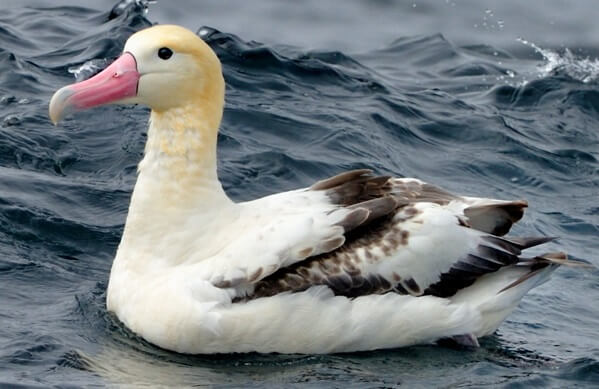
Scientific name: Phoebastria albatrus
Lifespan: around 45 years
Height: 84-94 centimeters (33-37 inches)
Weight: 4.3-8.5 kilograms
Wingspan: 215-230 centimeters (85-91 inches)
Short-tailed Albatrosses are also referred to as Steller’s Albatross in honor of the German botanist Georg Wilhelm Steller. This vulnerable albatross species breeds on the islands of Japan and is found in the temperate and subarctic regions of the North Pacific the rest of the year.
As their name suggests, Short-tailed Albatrosses have a rather short tail. The rest of their body is covered primarily in white plumage, except for their black flight feathers and coverts and a prominent black terminal bar on their tail. You’ll also see buff stains covering their crown and neck.
The feet of Short-tailed Albatrosses are pale blue in color. And while their large bills are pink, as they age, it develops a pale blue tip as well.
Their resemblance to seagulls:
While the predominantly white plumage and moderately long webbed feet of Short-tailed Albatrosses might appear similar to the gulls, the two have many distinguishing factors as well.
First and foremost is their wingspan, which is much longer in comparison. These albatrosses also have prominent buff stains on their crown and nape, which the gulls lack. Lastly, their short tail can easily be told apart from the longer, rounded, or squared-off tails of the latter.
Common Tern (Palau)
Scientific name: Sterna hirundo
Lifespan: around 12 years
Height: 31-35 centimeters (12-14 inches)
Weight: 110-141 grams
Wingspan: 77-98 centimeters (30-39 inches)
Belonging to the Laridae family, Common Terns are seabirds that breed in a wide habitat, unlike most of their relatives. These terns breed in the sub-arctic and temperate regions of North America, Europe, and Asia and prefer to spend their winters in coastal, tropical, and subtropical regions.
The upper parts and underparts of Common Terns vary from different shades of grey to stark white. Their heads are covered with a black cap, a splash of color on their otherwise light body. Their legs are orange-reddish, with a narrow, pointed bill.
There are four subspecies of Common Terns, with the most distinguishable feature among them being their bills’ color, ranging from mostly red with a black tip to completely black.
Their resemblance to seagulls:
Common Terns share the same plumage coloration as the gulls. However, they’re smaller in size, have a shorter wingspan, and have thin, pointy-edged bills.
Red-legged Kittiwake
Scientific name: Rissa brevirostris
Lifespan: around 4 years
Height: 35-39 centimeters (14-15 inches)
Weight: 325-510 grams
Wingspan: 84-92 centimeters (33-36 inches)
One of the only two Kittiwake species found in the world, the Red-legged Kittiwakes are a vulnerable seabird species endemic to the subarctic Pacific region.
The appearance of Red-legged Kittiwakes closely resembles that of Black-legged Kittiwakes. Both have a white head, neck, and underbody, with grey wings, a dark tail, and yellow bills. Only their bills are shorter, their wings are darker, and their heads are rounder. Also, as the name suggest, the former has red legs and feet, unlike the black ones of the latter.
Their resemblance to seagulls:
While the body structure and plumage coloration of Red-legged Kittiwakes closely resembles that of the gulls, their head is rounder, and their legs and bills are shorter.
Royal Tern
Scientific name: Thalasseus maximus
Lifespan: around 28 years
Height: 45-50 centimeters (18-20 inches)
Weight: 350-450 grams
Wingspan: 130 centimeters (51 inches)
Royal Terns are the second-largest member of the tern family, placed right after Caspian Terns. And while the two appear quite similar on the surface, the dark underwings of the latter work as a distinguishing factor between them.
Royal Terns are endemic to the Americas and have an overall white body with few exceptions. A pitch-black cap rests atop their head, which grows paler and patchier in the non-breeding months. Their eyes, feet, and legs are also black in color, while their short, pointed bill is bright orange. The sexes of this species display no sexual dimorphism.
Their resemblance to seagulls:
The mostly white plumage of Royal Terns can easily be mistaken for that of a gull. However, they possess a slenderer body in comparison, and their bills are conical and pointy-edged.
Long-tailed Jaeger

Scientific name: Stercorarius longicaudus
Lifespan: around 10 years
Height: 38-58 centimeters (15-23 inches)
Weight: 230-444 grams
Wingspan: 102-117 centimeters (40-46 inches)
Long-tailed Jaegers are the smallest member of the Skua family that breed in the high arctics of North America and Eurasia and migrate to the south Pacific and Atlantic during winters.
As you can gather from their name, these seabirds are quite long-tailed; in fact, their tails makes up most their body length. Just like their long, black tail, the rest of their physical characteristics are just as easily recognizable.
They have a white face, chest, and belly, with a grey tinge spreading over their rump and covering all of their upperbody, including their legs and wings, with the edges being darker. On their head is a dark cap, with dark eyes and bills with a curved end.
Their face has a touch of buff, which grows brighter in the breeding months. Both sexes of these species display identical physical attributes, displaying no dimorphism.
Their resemblance to seagulls:
While Long-tailed Jaegers have a white and grey plumage like the gulls, their head cap, shorter bills, and longer tail set the two birds apart.
Brown Booby

Scientific name: Sula leucogaster
Lifespan: around 16 years
Height: 75 centimeters (30 inches) in males; 80 centimeters (31 inches) in females
Weight: 1 kilogram in males; 1.3 kilograms in females
Wingspan: 140 centimeters (4.6 feet) in males; 150 centimeters (4.9 feet) in females
Regarded as the most widespread and abundant member of the sulid family, the Brown Booby is a large seabird infamous for its clumsy takeoffs and landings. You’ll find them on the coasts and islands of the Pacific and Atlantic oceans.
As their name suggests, most of their upperbody is brown in color, with their head, neck, and tail being of a richer shade than their wings. Their breast and rump are pure white in contrast, with large yellow webbed feet and pale bills with touches of yellow at the base.
The adult Brown Boobies are highly sexually dimorphic, with the females being substantially larger and heavier than their male counterparts.
Their resemblance to seagulls:
Just like the gulls, Brown Boobies also have a white underbody and webbed legs. But that’s where all similarities between them end. Brown Boobies have a dark brown head, unlike gulls’ white one. Their large bills are also placed higher on their face than the gulls.
Black Skimmer
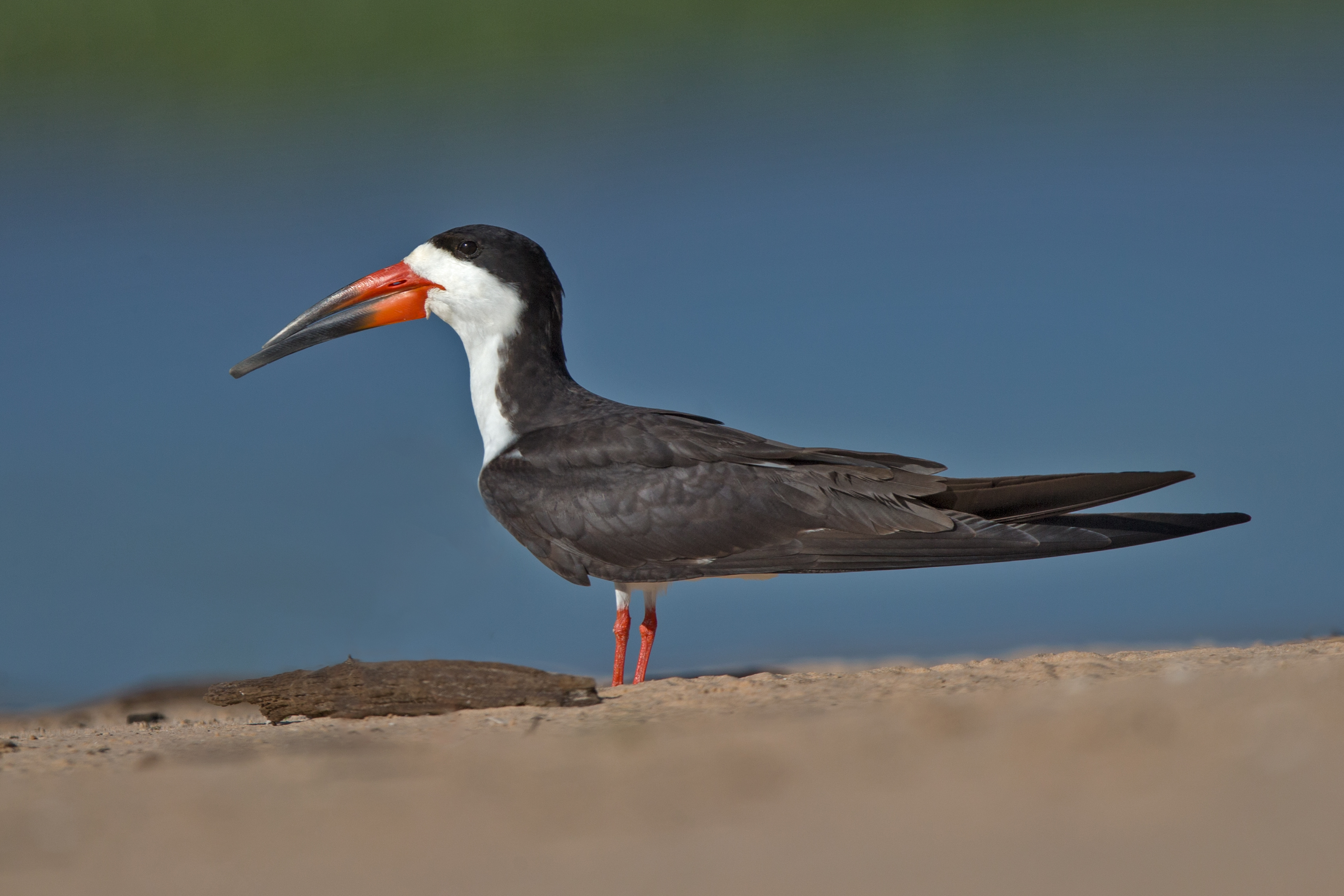
Scientific name: Rhynchops niger
Lifespan: around 5-15 years
Height: 40-50 centimeters (16-20 inches)
Weight: 212-447 grams
Wingspan: 107-127 centimeters (42-50 inches)
Although Black Skimmers have an uncanny resemblance with the terns, from a distance, you can easily confuse them for a gull. Breeding across both North and South America, these skimmers travel south to warmer regions during winters.
Being the largest of the three Skimmer species, these birds have a pitch-black head cap, neck, and upperbody, with a white forehead and underbody in the breeding months. Their tail and rump are greyish in color, with red legs and feet. Their non-breeding plumage is more on the pale brown side.
The bill of these birds has a dark orange base, while the rest of it is mainly black. Their dark brown eyes are quite extraordinary for having vertical pupils, like that of cats. Both sexes appear similar, only the females are smaller and weigh lighter than the males.
Their resemblance to seagulls:
Just like the gulls, Black Skimmers also have black and white plumage. However, their bodies are slenderer, and their legs are shorter. Lastly, their bill structure – long and conical, with a longer lower mandible – is nothing like that of gulls.
Cory’s Shearwater
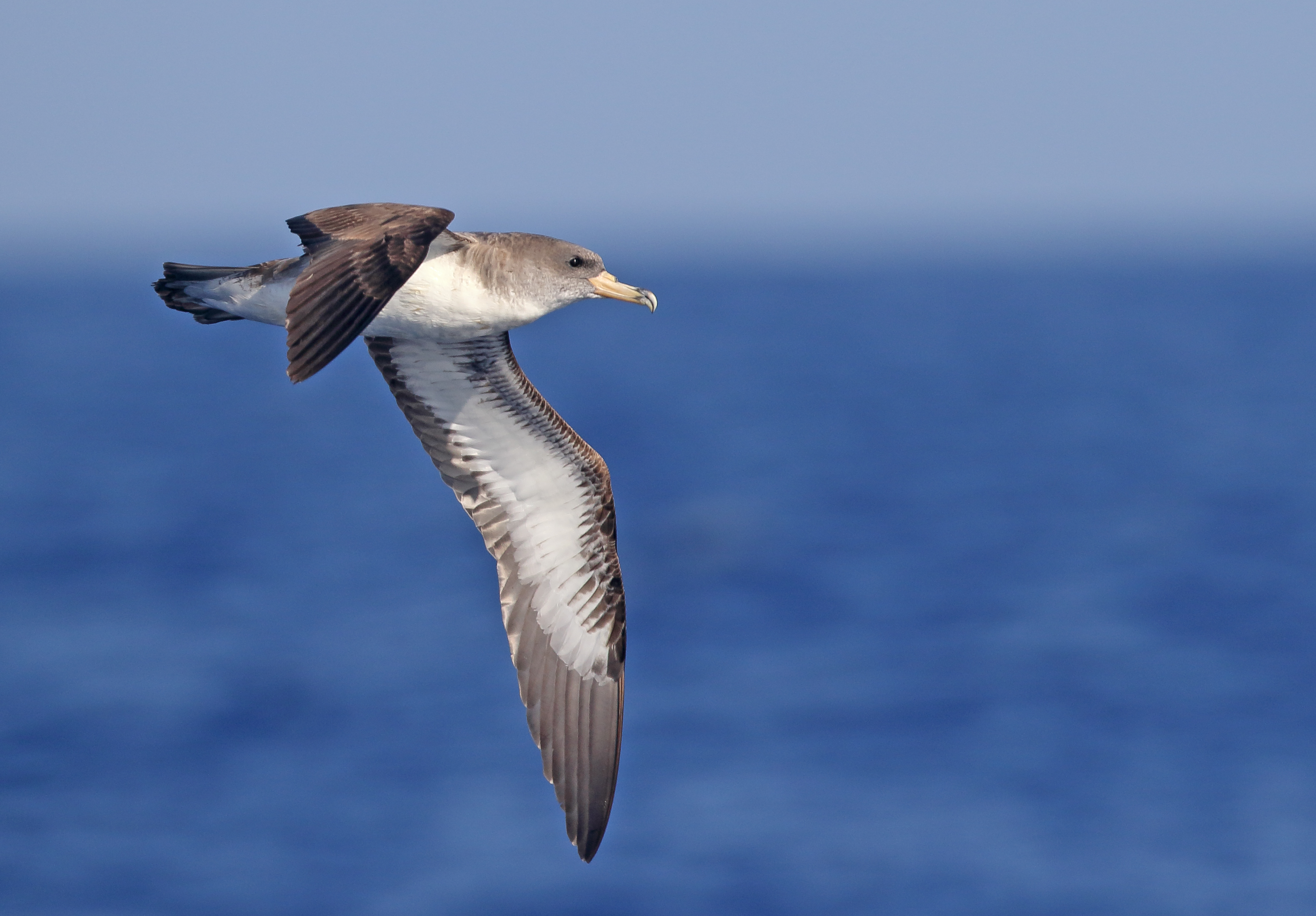
Scientific name: Caronectris borealis
Lifespan: around 55 years
Height: 45-56 centimeters (18-22 inches)
Weight: 530 grams
Wingspan: 112-126 centimeters (44-50 inches)
Named after the American ornithologist, Charles B. Cory, Cory’s Shearwaters are large colonial-breeding seabirds found on the rocky islands of the Atlantic. They’re equally skilled at gliding and deep diving and create quite a ruckus in their colonies with their cackling calls.
In appearance, Cory’s Shearwaters are quite similar to Great Shearwaters; only their black cap and dark shoulder markings are absent in this species. Their upperbody is greyish brown, with darker markings on their wings, while the underparts are white. The bill of these birds is a faint shade of yellow, with a black marking on the tip.
Their resemblance to seagulls:
The white underbody and heavy, hook-ended bills of Cory’s Shearwaters make them look like gulls. On the other hand, their darker face and shorter legs set the two apart.
Forster’s Tern
Scientific name: Sterna forsteri
Lifespan: around 12 years
Height: 33-36 centimeters (13-14 inches)
Weight: 130-190 grams
Wingspan: 64-70 centimeters (25-28 inches)
Named after the German naturalist Johann Forster, Forster’s Terns are a small tern species that breed in North American inland and migrate to northern Central America and the Caribbean during winters.
Forster’s Terns have a slender body that is mostly white in color, except for touches of pale grey on their wings and deeply forked tails. Their legs and feet are red in color, and so is their bill, with a dark tip. They also have a black cap atop their head which disappears during winters, leaving only black oval spots around their eyes.
Their resemblance to seagulls:
While the plumage of Forster’s Terns looks just like the gulls, you can tell them apart by their dark head cap, thin, pointed bills, and shorter legs.
African Skimmer

Scientific name: Rhynchops flavirostris
Lifespan: around 12-15 years
Height: 38 centimeters (15 inches)
Weight: 110-200 grams
Wingspan: 106 centimeters (41 inches)
Found along the lakes, rivers, and lagoons of the sub-Saharan regions of Africa, African Skimmers are a near-threatened skimmer species popular for their sharp kip-kip calls.
These seabirds have a white face, chest, and underbody, while the crown of their head, eyes, hind neck, back, wings, and deeply-forked tail are all black in contrast. Their bills, just like their legs and feet, are orangish-yellow in color.
However, the tip of these bills is faded cream in color (almost translucent), and the lower mandible is considerably longer than the upper one. This has also led to them being named flavirostris (their binominal name), which is Latin for yellow-beak.
Their resemblance to seagulls:
Much like Black Skimmers, African Skimmers possess a plumage just like the gulls. However, their slenderer body and bills – conical, with the lower mandible longer than the upper one – set the two apart.
Galapagos Shearwater
Scientific name: Puffinus subalaris
Lifespan: around 19 years
Height: 29-31 centimeters (11-12 inches)
Weight: 123-225 grams
Wingspan: 63 centimeters (24 inches)
Initially regarded as a subspecies of Audubon’s Shearwaters, Galapagos Shearwaters have recently received the status of an individual species with an ancient lineage. They’re small seabirds that breed on the Galapagos Islands, as their name indicates, and seldom migrate during winters.
These gregarious seabirds have a white face and underbody, while their upper parts, flight feathers, and under tail are greyish-black. Their eyes are dark, and so are their curved bills, with the upper mandible darker than the lower one. Both sexes of Galapagos Shearwaters look identical.
Their resemblance to seagulls:
The plumage and hooked bill of Galapagos Shearwaters is similar to that of the gulls. However, their dark head and shorter legs set these birds apart.
Fork-tailed Storm-Petrel
Scientific name: Hydrobates furcatus
Lifespan: around 18 years
Height: 20 centimeters (7 inches)
Weight: 54-59 grams
Wingspan: 46 centimeters (18 inches)
Despite being one of the smallest members of the storm petrel family, the Fork-tailed Storm Petrels stand out because of their bluish-grey plumage, which no other relative shares.
These pelagic seabirds dwell in the northern Pacific Ocean and are found on land only during their breeding season. While their upperbody is covered in bluish-grey, the underparts are much paler. Their face is remarkable, with a dark grey forehead, black ear patches, and small, black bills.
Both sexes of these petrels closely resemble each other in appearance, leaving no room for sexual dimorphism.
Their resemblance to seagulls:
The only similarity between Fork-tailed Storm Petrel and seagulls is their plumage, because these seabirds are much smaller in size than the latter.
Laysan Albatross
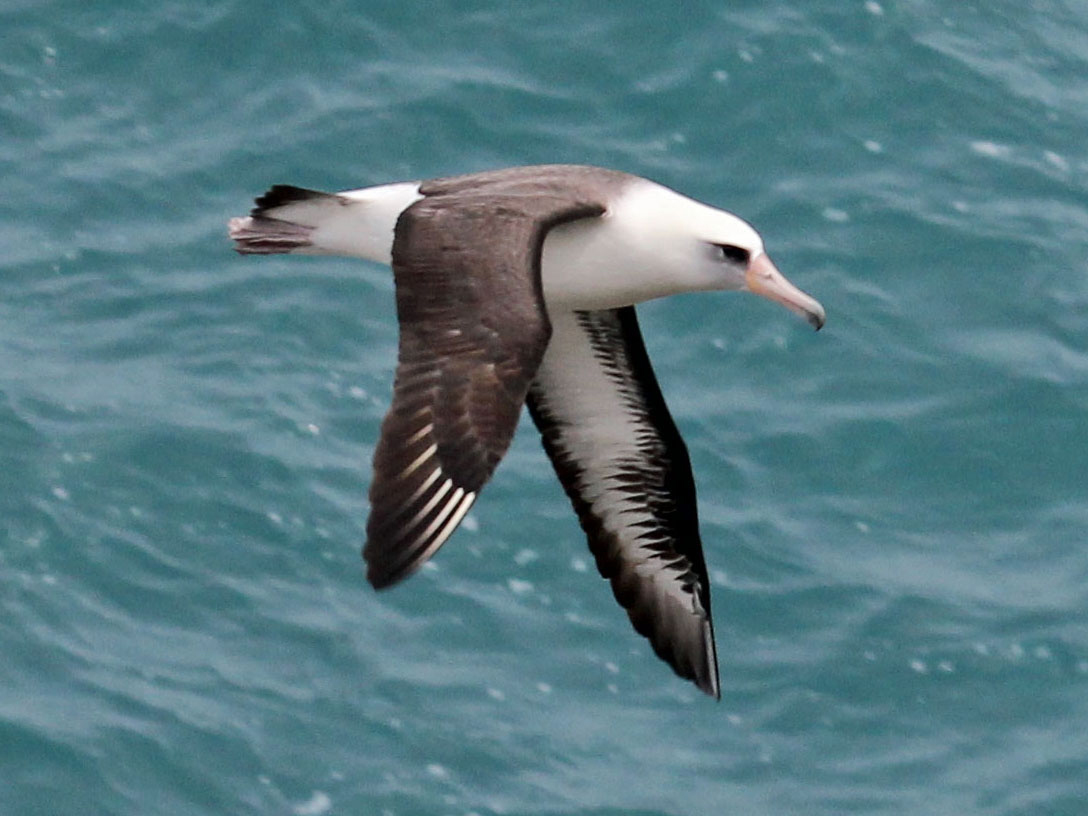
Scientific name: Phoebastria immutabilis
Lifespan: around 40 years
Height: 81 centimeters (32 inches)
Weight: 2.4-4.1 kilograms in males; 1.9-3.6 kilograms in females
Wingspan: 195-203 centimeters (77-80 inches)
Laysan Albatrosses get its name from one of its highly populated breeding colonies, Laysan, in the Northwestern Hawaiian Islands. These seabirds are also the second-most populated seabird species in the Northwestern Hawaiian Islands, with their numbers still increasing.
Their upper wings, back, rump and tail are washed in a greyish-black hue. The underparts, on the other hand, are all white. The pattern on the underwing varies among individuals, with narrow or thick black margins.
Laysan Albatrosses’ bills are long, hooked, and pink in color with darker tips. They also have circular black smudges around their eyes. The adults display sexual dimorphism in terms of size, with the males being slightly larger, but not in plumage coloration.
The resemblance with seagulls:
With their white plumage, dark wings, and hooked bill, Laysan Albatrosses resemble gulls closely. Their larger size, longer wings, and the black smudge around their eyes are the only distinguishing factors between the two.
Audubon’s Shearwater
Scientific name: Puffinus lherminieri
Lifespan: around 19 years
Height: 30-33 centimeters (12-13 inches)
Weight: 150-230 kilograms
Wingspan: 64-72 centimeters (25-28 inches)
Also referred to as Dusky-backed Shearwater, Audubon’s Shearwaters are small seabirds named after the self-taught American ornithologist, John Audubon. They dwell in the tropical waters of the Caribbean, Central Pacific, eastern Atlantic, and the Indian Ocean. Unlike the larger members of their family, these seabirds are largely sedentary.
The appearance of Audubon’s Shearwaters resembles that of Manx Shearwaters, with the same blackish-brown head cap, back, wings, and tail contrasting with a white face and underbody. Differentiating factors between the two include the longer bill and white under the tail of the latter.
The legs and feet of these birds are dull Pink in color, with a wash of black over them. There’s no visible difference in the appearances of both sexes.
Their resemblance to seagulls:
Much like the other Shearwaters, Audubon’s Shearwaters also appear similar to gulls due to their white face and underbody and their heavy, hook-ended bills. However, their short legs and touches of grey atop their head distinguish them from the gulls.
Sooty Tern
Scientific name: Onychoprion fuscatus
Lifespan: around 32 years
Height: 33-36 centimeters (13-14 inches)
Weight: 180 grams
Wingspan: 82-94 centimeters (32-37 inches)
Endemic to the tropical oceans, Sooty Terns are often referred to as the “true seabirds,” due to their habitat and behavioral tendencies. These birds prefer to stay on the water most of the time, only coming back to islands for roosting. In fact, they can even stay out on the sea for about 3-10 years.
These seabirds are also called Wideawake Terns or simply Wideawake because of their noisiness around their nesting colonies.
Sooty Terns have jet black upper parts and white under parts, with long wings and a long, forked tail. They have a black cap on their head and a stark white forehead. They have black legs and red bills with a black tip. Their wings and tails are also black on the upper side, with white underwings.
Their resemblance to seagulls:
The brilliant black and white plumage of Sooty Terns resemble that of the seagulls. However, they’re quite small in size, possess shorter legs, and conical, pointed bills.
Bonin Petrel
Scientific name: Pterodroma hypoleuca
Lifespan: around 15 years
Height: 30 centimeters (11 inches)
Weight: 170 grams
Wingspan: 67 centimeters (26 inches)
Bonin Petrels are found in the Northwestern Pacific Ocean, and are endemic to the Northwestern Hawaiian Islands. These seabirds are highly secretive and always create remote colonies, which is why not much is known about their biology and general behavior.
Bonin Petrels have greyish upper parts and white underparts, with a black, M-shaped pattern on the upper wings. There are bold black patterns on their white underwings, which create an intricate pattern visible in flight.
They have black caps on their head, with a white forehead. Their beaks are long, pure black in color, with the upper beak hooked at the end. Their legs and feet are light Pink with a few darker patches.
Their resemblance to seagulls:
The only similarity between Bonin Petrels and seagulls is their plumage coloration. These seabirds are smaller in size than the gulls, and have shorter, although hook-tipped, bills. Their legs are also shorter than gulls.
Wrapping it up
While seagulls are both beautiful and intelligent seabirds, they’re not the only ones that you spot on seasides. There are many other seabird families and subfamilies out there, including the sulids, petrels, shearwaters, noddies, skimmers, and skuas.
Above, we’ve talked about such seabirds that are commonly mistaken for gulls due to the resemblance in their appearance but are actually quite different in terms of diet, flight, and lifestyle. We’ve also described their physical traits and habitat range in-depth to help you distinguish them from the gulls.
The next time you’re on the beach and spot a seagull-like bird, you’d be able to recognize them right away.
